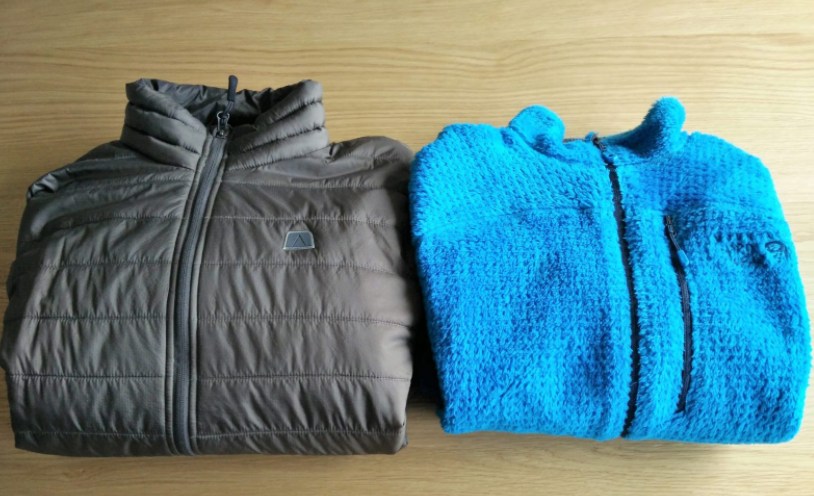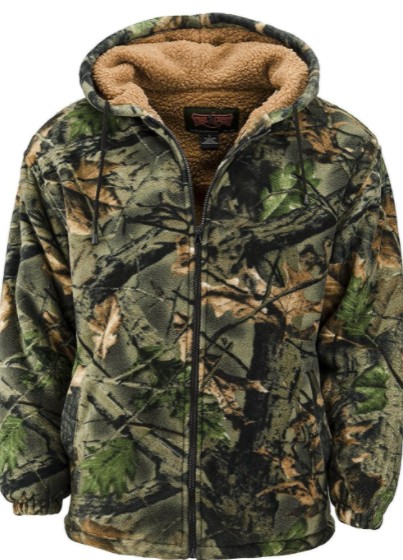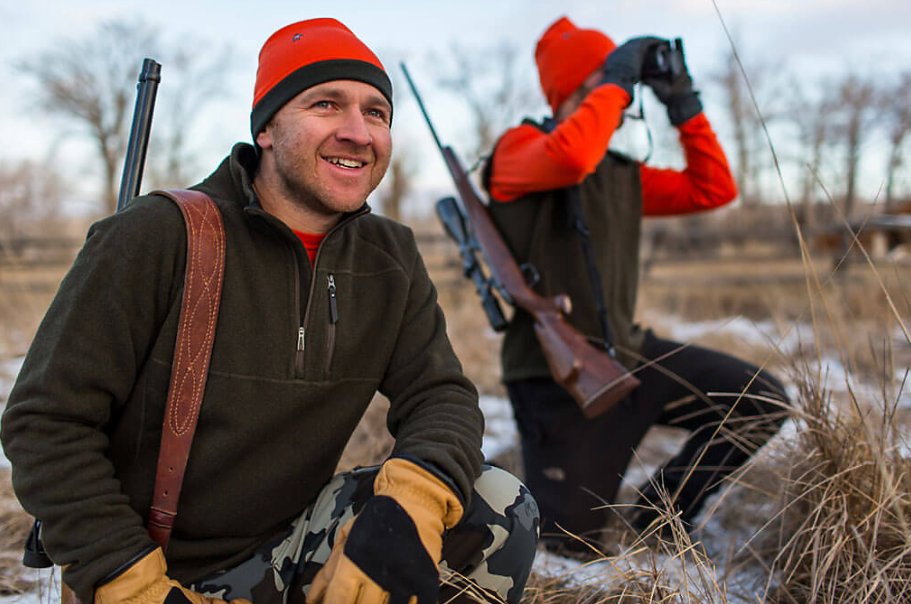With the onset of winter, you have quite a few options to dress in. However, if you plan on going on a hunt, you need to consider a few points before choosing the perfect material. Though hunting is a popular sport in the winters, the chilling cold outside makes it difficult to carry out the activity. Besides, your winter wear for hunting will determine how long you can stay outside, thereby increasing your success rate. Thus, it is important to know the difference between popular hunting wear material, here I bring you the comparison of wool vs fleece for hunting.

But thankfully, you can manage it by wearing certain materials as layers. But the question is, which one?
Fleece vs Wool for Hunting: Full Detailed Comparison
We have two popular options for you today, fleece vs. wool. So let’s check out which one is the perfect pick for the hunting trips.
Fleece

Fleece is a synthetic fabric made from polyethylene terephthalate. However, it can be made from other synthetic fibers and natural and synthetic fiber blends. Fleece is often a popular choice due to its fluff during the winter months, but is it a good option for hunting?
Let’s find that with the pros and cons.
Pros
Breathable:
During a hunt, you want to stay comfortable, thereby allowing air to pass through easily while keeping you warm. Fleece makes way for that. Plus, it does not absorb water, which is an added advantage. Surely you will be sweating on a hunt (even during winters), but you are sure to remain comfortable with a fleece layer.
Quick-drying:
Winter hunting can often be damp; you may also have to get down in the water or lie on your stomach on a damp patch of grass to wait for your prey. Even if you are successful, it is sure to be uncomfortable in wet clothes that too in winter. Thankfully, with a fleece layer, you need not worry, for it dries quickly. Since fleece fibers are hydrophobic, they repel water instead of absorbing it. Plus, fleece has sweat-wicking quality, which allows it to dry faster.
Lightweight:
As a rule of thumb, you want to be dressed in lightweight clothes on a hunt. You will need freedom of space to move swiftly, and having heavy clothes on will only restrict your movement. An average fleece jacket weighs between 8 to 12 ounces which is about 4-5 ounces lighter than a woolen sweater. Plus, it is way lighter than wool, even when the fleece is wet. This characteristic of fleece makes it the ideal hunt wear during winter.
Cons
While some solid points support wearing fleece during the winter months, there are certain cons that you need to consider before you make your pick.
Fleece is not sustainable:
Polyethylene terephthalate, used in the manufacturing of fleece, is made from petroleum, a non-renewable source. Besides, fleece does not have the durability of wool. Therefore, you will have to replace your fleece jacket quite a few times if you wear it frequently to hunts, which impacts the environment and is expensive.
Develops odor:
Unlike wool, fleece does not have antibacterial or antimicrobial properties. Thus, fleece gets smelly quicker than wool. The smell can be due to sweat, dampness, or even mildew. And since there is no way to avoid dampness and some sweat during hunts, fleece may not be a good choice.
Requires frequent washing:
Since fleece gets smelly easily, it requires frequent washing to keep it clean. You may have to wash your fleece jacket after every 2-3 wears if it’s your preferred hunting wear, while with wool, you can lengthen this time.
Wool
Wool is sourced from a natural source and is one of the preferred and most popular winter options, even for hunting. However, you can make a better choice after knowing its pros and cons.

Pros
Breathable
Wool is one of the preferred choices as a base layer for all winter hunters. Ideally, the base layer should be breathable with the ability to repel moisture from the body. Wool meets this requirement, thereby keeping the body temperature regulated and avoiding getting soaked with sweat.
Quick-drying
As a rule of thumb, the thinner the wool, the faster it will dry. And light wool sweaters or cardigans can be worn as a base layer for your hunting trips. Since hunting in winters gets damp and even soggy, having a quick-drying option like wool is essential.
Flame resistant
Though chances of a fire are very low during winter months in a forest and are often redundant during a hunt, it’s nice to have additional features. Wool’s flame resistance is higher than fleece, making it a popular choice for hunters who are likely to set up a campfire after their successful trip.
Wool stays insulated even when wet
Even when wet, wool retains a lot of its loft and fluff. It can still provide some form of insulation and will thus come in handy during your winter hunts.
Cons
Like fleece, wool suffers from some cons, which you should consider before making your pick.
Expensive
Unlike fleece, wool is quite expensive since it has a natural source. So if you are looking for a nice wool jacket, it should cost you something between $150- $300.
Bulky
Since wool has a nice fluff and provides a certain loft, it is often difficult to compress and takes quite some space to pack.
Not all are comfortable
There are certain woolen wears that are uncomfortable and itchy. Wearing such a sweater as your base layer on a hunting trip can be both uncomfortable and distracting.
It takes time to dry
As mentioned earlier, there is a chance of getting wet during winter hunting. In such a situation, wool can be problematic as it gets too heavy when wet and takes quite some time to dry if it’s thick.
High maintenance
Unlike fleece which you can wash easily without much precaution, wool requires much care. You have to use special softeners and detergents to wash wool, plus often it cannot be machine washed.
Even though fleece and wool have their cons, they are two of the most popular choices for winter hunting. Having said that, choosing between them is essential for your next hunting trip.
Fleece vs Wool for Hunting: FAQs
Is Fleece Good For Hunting?
Fleece is an excellent choice to be a part of your hunting ensemble. Since most hunting wears are worn in layers, fleece can be a perfect option to warm you. In addition, since fleece is a non-absorbant fabric and is highly breathable, hunters and enthusiasts are incredibly fond of it. However, it must be borne in mind that fleece is not windproof.
Is Wool Good For Hunting?
Wool is a popular choice of hunt wear material since it’s breathable and moisture resistant. Wool is also insulating by nature, keeping one warm in cold weather and vice versa. Plus, since the material is layered, you can make adjustments based on exertion.
As per many hunters, wool is the best material to wear next to your skin during winter as it keeps one warm and comfortable during the cold winter conditions.
Is Wool Better than Fleece?
Both wool and fleece have desirable and undesirable properties; however, both are popular in their own right. It finally boils down to what you choose. For instance, wool is your ideal choice if you like dressing in natural materials for your winter hunt. However, if you want to keep your layers light, fleece is the fabric to opt for. However, wool is fire resistant which is one of the characteristics that fleece does not have. So, if camping is involved and you plan to be a part of a campfire, opting for a wool layer is ideal.
Conclusion:
Winter is the time to try out different activities, have a gala hunting in the forest, and enjoy the core! But to ensure a successful hunting trip, make sure your winter layers are proper to get the maximum comfort and freedom of movement required to hunt. This article has covered all that you need to know about wool vs fleece for hunting to help you make the ideal choice. So pick one and gear up for your first hunting trip this winter!
